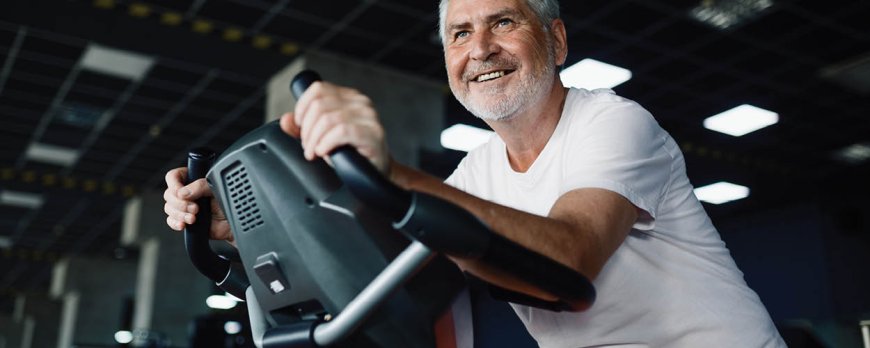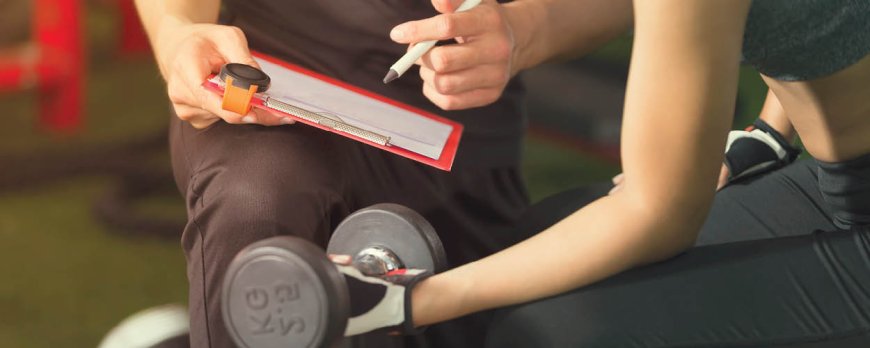What are the 6 skill areas of fitness?
Explore 'What are the 6 skill areas of fitness?' Uncover how balance, coordination, power, reaction time, agility, and speed can elevate your fitness level.

What are the 6 Skill Areas of Fitness?
When it comes to achieving peak physical fitness, it is essential to focus on developing the 6 skill areas of fitness. These skill-related fitness components play a crucial role in improving athletic performance and excelling in specific sports and activities.
Key Takeaways:
- The 6 skill areas of fitness are agility, balance, coordination, power, reaction time, and speed.
- Agility involves the ability to move quickly and change direction easily.
- Balance refers to the ability to maintain stability in stillness and movement.
- Coordination is the ability to control body movements, especially of the limbs.
- Power is the ability to apply maximum force quickly.

Understanding Skill-Related Fitness
Skill-related fitness refers to the physical attributes and abilities that contribute to an individual's overall performance in specific sports and activities. These components of fitness go beyond the traditional measures of strength and endurance, focusing on the skills necessary to excel in various athletic pursuits.
There are six key skill areas of fitness that are integral to athletic performance: agility, balance, coordination, power, reaction time, and speed. Each of these areas plays a unique role in enhancing an athlete's ability to perform at their best.
Here is a breakdown of the six skill areas of fitness:
- Agility: This skill involves the ability to move quickly and change direction with ease. It is crucial for sports that require sudden changes in direction or quick movements, such as basketball or tennis.
- Balance: Maintaining stability both in stillness and during movement is essential for athletes across various disciplines. Good balance helps prevent falls, improves posture, and enhances overall body control.
- Coordination: The ability to control body movements, especially those of the limbs, is vital for precise and efficient performance. Coordination is essential in sports like gymnastics or soccer, where precise movements and timing are crucial.
- Power: Power refers to the ability to apply maximum force quickly. It plays a significant role in explosive movements, such as jumping or throwing, and is crucial for athletes engaged in sports like weightlifting or sprinting.
- Reaction Time: Quick response to external stimuli is essential in many sports. Reaction time measures how quickly an athlete can process and react to a stimulus, such as a starting signal or an opponent's move.
- Speed: The ability to move through space in the shortest time possible is crucial in sports that involve fast-paced actions, such as track and field or swimming. Speed is a combination of stride length and frequency.
By focusing on developing these skill areas, athletes can enhance their overall performance in their chosen sport or activity. Training and practicing specific exercises that target these skills can lead to improvements in speed, agility, power, and overall coordination. The combination of these skill-related fitness components, along with other facets of physical fitness, can help athletes reach their full potential and excel in their chosen endeavors.

Agility: Moving Quickly and Changing Direction
Agility is a crucial skill area of fitness that enables individuals to navigate through various movements and change direction rapidly. It plays a vital role in sports and activities that require quick movements, such as basketball, soccer, and tennis. Developing agility can enhance performance and help prevent injuries by improving an individual's ability to react swiftly to different situations. Here are some key aspects of agility:
- Bodily Control: Agility requires a high level of control over the body's movements. This includes being able to stop, start, and change direction with precision and fluidity.
- Quick Reflexes: Having fast reflexes allows athletes to respond promptly to unexpected stimuli, such as dodging an opponent or catching a ball.
- Balance and Coordination: Agility relies on maintaining balance while executing rapid movements. Coordination between different muscle groups is essential to move efficiently and avoid stumbling or falling.
Agility Training
To improve agility, athletes can incorporate specific training exercises into their fitness routines. These exercises focus on enhancing reaction time, coordination, and overall body control. Here are some examples of agility training exercises:
- Agility ladder drills: These involve performing various footwork patterns in and around a ladder placed on the ground, promoting quick feet movement and coordination.
- Cone drills: Setting up cones in different patterns and directions helps athletes practice changing direction rapidly while maintaining balance.
- Reaction drills: These drills involve reacting to auditory or visual cues to develop quick reflexes, such as sprinting in response to a whistle or catching a ball thrown from different angles.
By incorporating agility training into their fitness routines, athletes can enhance their overall performance and feel more confident in their ability to move swiftly and change direction with ease. Developing agility is not only beneficial for athletes but also for individuals looking to improve their general fitness levels and mobility.

Balance: Maintaining Stability in Stillness and Movement
Balance is an essential skill area of fitness that allows individuals to maintain stability and control their body position in various physical activities. It plays a crucial role in everyday movements, such as walking, standing, and reaching, as well as in more dynamic activities like running, jumping, and playing sports. By developing a strong sense of balance, athletes can improve their overall performance and reduce the risk of injuries.
One way to enhance balance is through functional fitness exercises that focus on stability and control. These exercises challenge the body's ability to maintain equilibrium, which in turn strengthens the muscles responsible for balance. Examples of such exercises include single-leg stands, yoga poses, and balance boards. By incorporating these exercises into a training routine, athletes can improve their stability, coordination, and proprioception, leading to better overall athletic performance.
Benefits of Balance Training:
- Improved stability and coordination
- Enhanced body control and posture
- Reduced risk of falls and injuries
- Increased agility and reaction time
- Better performance in sports and activities that require balance and agility
Whether you're a professional athlete or a fitness enthusiast, focusing on improving balance can have a significant impact on your overall physical fitness. By incorporating balance training exercises into your workout routine, you can enhance your stability, coordination, and control, leading to better performance and reduced risk of injuries. So, challenge yourself and take a step towards achieving optimal balance for a healthier and more active lifestyle.
Coordination: Controlling Body Movements
Coordination is a key skill area of fitness that involves the ability to synchronize and control body movements to perform specific tasks or exercises effectively. It plays a crucial role in various sports and physical activities, enabling athletes to execute precise movements with accuracy and efficiency. Developing coordination is vital for improving overall performance and reducing the risk of injuries.
Enhancing coordination requires practice and focus on specific exercises that challenge the body's ability to coordinate movements. By incorporating balance exercises, such as standing on one leg or performing yoga poses, individuals can improve their overall coordination skills. Additionally, activities that involve hand-eye coordination, like throwing and catching a ball or playing table tennis, can also help sharpen coordination abilities.
H3: Benefits of Developing Coordination
- Improved motor skills and reaction time
- Enhanced performance in sports and physical activities
- Better posture and body control
- Reduced risk of injuries
- Increased overall body awareness
By incorporating coordination exercises into their fitness routines, athletes can fine-tune their ability to control and synchronize body movements. This, in turn, can lead to improved performance, agility, and overall physical fitness.

Power: Applying Maximum Force Quickly
Power is a vital skill area of fitness that involves the ability to exert maximum force in a short amount of time, resulting in improved athletic performance. It plays a significant role in explosive movements and activities that require bursts of strength and speed. By developing power, athletes can enhance their ability to generate force and perform at their best.
To improve power, athletes can incorporate specific exercises and training techniques into their fitness routine. Here are some effective ways to enhance power:
- Plyometric exercises: This type of training focuses on explosive movements, such as jump squats and box jumps. Plyometrics help improve power by training the muscle fibers to generate force rapidly.
- Olympic lifting: Olympic lifts like the clean and jerk and the snatch are excellent for developing power. These complex movements require coordinated efforts from multiple muscle groups, enhancing explosive strength.
- Functional training: Incorporating functional movements into workouts can improve power by simulating real-life activities. Exercises like medicine ball throws and kettlebell swings engage multiple muscle groups and promote power development.
By incorporating power-focused exercises into their training regimen, athletes can enhance their explosive strength and improve their overall athletic performance. It is important to note that power training should be done under the guidance of a qualified fitness professional to ensure proper form and technique.
Reaction Time: Quick Response to External Stimuli
Reaction time is a fundamental skill area of fitness that measures the speed at which an individual can respond to an external stimulus. It plays a crucial role in various sports and activities, where quick reactions can make all the difference between success and failure.
When it comes to fitness skills, reaction time is often overlooked but is equally important as other components. It involves the ability to process information quickly and initiate a motor response rapidly. Athletes with fast reaction times can anticipate and react swiftly to changes in their environment, gaining an advantage over their opponents.
Factors Affecting Reaction Time:
- Age: Reaction time tends to decline with age due to changes in the central nervous system.
- Genetics: Some individuals may have a natural predisposition for quicker reaction times.
- Training: Regular practice and specialized training can improve reaction time in athletes.
- Environment: External factors such as lighting conditions and distractions can impact reaction time.
To enhance their reaction time, athletes can engage in specific training exercises that focus on improving their sensory perception, decision-making abilities, and motor response. These exercises may include drills that simulate game-like scenarios, such as responding to visual cues or auditory signals.
By developing their reaction time as part of their fitness training, athletes can sharpen their reflexes and make split-second decisions, giving them a competitive edge in their sport of choice.
Speed: Moving Efficiently in Shortest Time
Speed is a critical skill area of fitness that determines how quickly an individual can move from one point to another. It plays a significant role in various sports and activities, such as sprinting, soccer, basketball, and tennis. To improve speed, athletes focus on enhancing their stride length, stride frequency, and overall running mechanics.
When it comes to speed training, several key factors must be considered. First and foremost, proper technique is essential. Athletes need to maintain proper form, including a strong and stable core, relaxed upper body, and powerful leg drive. Additionally, explosive power is crucial for generating the necessary force to propel the body forward.
Key components for developing speed:
- Proper running mechanics
- Explosive power
- Strength and conditioning exercises
- Plyometric training
- Interval training
- Sprint drills
By incorporating these components into their training regimen, athletes can improve their speed and overall performance. It's important to note that speed development takes time and consistent effort. It requires a combination of focused training, proper rest and recovery, and a well-rounded fitness program that addresses all skill areas of fitness.
Speed not only benefits athletes in their respective sports but also contributes to overall fitness and health. By developing speed, individuals can enhance their cardiovascular endurance, muscular strength, and body composition. This skill area of fitness is not limited to athletes; it is relevant to anyone who wants to improve their physical capabilities and lead an active lifestyle.

Enhancing Performance Through Skill Areas of Fitness
By focusing on developing the skill areas of fitness, athletes can significantly improve their performance in their chosen sports or activities. These skill areas, including agility, balance, coordination, power, reaction time, and speed, play a crucial role in enhancing athletic capabilities and overall physical fitness.
Agility
Agility is the ability to move quickly and change direction with ease. It allows athletes to navigate through varying terrain, dodge opponents, and react swiftly to game situations. Agility training involves drills and exercises that challenge an individual's speed, coordination, and balance. By improving agility, athletes can enhance their ability to move effectively and efficiently, gaining an edge in their sport or activity.
Balance
Balance is essential for maintaining stability both during stillness and movement. It is a foundational skill that supports all other aspects of fitness. Athletes with good balance have an advantage in activities that require control, such as gymnastics or martial arts. Balance training incorporates exercises that challenge an individual's core stability and proprioception, helping them maintain control and prevent injuries.
Coordination
Coordination is the ability to control body movements, particularly those of the limbs. It enables athletes to perform complex motor skills efficiently and accurately. Sports such as basketball, soccer, and dance rely heavily on coordination for precise movement execution. Coordination training involves drills that focus on improving rhythm, timing, and body awareness, allowing athletes to perform at their best.
Power
Power is the ability to apply maximum force quickly. It is crucial for explosive movements like jumping, throwing, and sprinting. Athletes who possess great power can generate more force in less time, leading to improved performance. Power training involves exercises that focus on developing muscular strength and speed, such as plyometrics and Olympic lifts.
Reaction Time
Reaction time is the time it takes for an individual to respond to an external stimulus. It plays a vital role in sports where quick decision-making is crucial, such as tennis or boxing. Reaction time training utilizes drills and exercises that challenge an athlete's ability to recognize and react to stimuli, enhancing their response speed and accuracy.
Speed
Speed is the ability to move through space in the shortest time possible. It is essential for sports that require fast running or rapid movements, such as track and field or football. Speed training includes exercises and drills that aim to improve stride length, frequency, and overall running mechanics, allowing athletes to reach their full potential in terms of speed.
By incorporating specific training regimens targeting these skill areas of fitness, athletes can optimize their performance and excel in their chosen sports or activities. Developing agility, balance, coordination, power, reaction time, and speed not only enhances athletic capabilities but also contributes to overall physical fitness and injury prevention. So, whether you are a professional athlete or simply looking to improve your fitness level, focusing on these skill areas will undoubtedly help you reach new heights.
Conclusion
Developing the 6 skill areas of fitness, including agility, balance, coordination, power, reaction time, and speed, is crucial for individuals aiming to excel in their chosen physical pursuits. These skill components of fitness play a fundamental role in enhancing athletic performance and improving overall physical fitness.
Agility is essential in fitness training as it allows individuals to move quickly and change direction with ease. By improving agility, athletes can react faster and navigate through various obstacles during sports or other physical activities.
Balance is another vital skill area that contributes to overall stability. Whether in stillness or movement, maintaining balance is crucial for athletes to perform at their best. By enhancing their ability to stay balanced, individuals can have better control over their body and prevent injuries.
Coordination plays a critical role in controlling body movements, particularly the limbs. Good coordination is necessary for athletes to perform complex movements with precision and efficiency. By developing coordination, athletes can improve their performance in sports that require precise movements, such as gymnastics or dance.
Power is the ability to apply maximum force quickly. It is a key skill area for explosive movements, such as sprinting, jumping, or throwing. By developing power, athletes can generate more force in a shorter amount of time, leading to improved performance in power-based sports or activities.
Reaction time refers to how quickly an individual can respond to external stimuli. It is crucial in sports or activities that require quick reflexes, such as martial arts or basketball. By training reaction time, athletes can enhance their ability to react swiftly and make split-second decisions.
Speed is the ability to move through space in the shortest time possible. It is a fundamental skill area in many sports, including track and field, soccer, and swimming. By focusing on improving speed, athletes can increase their overall performance and outpace their competitors.
In conclusion, by developing the 6 skill areas of fitness – agility, balance, coordination, power, reaction time, and speed – individuals can enhance their performance in their chosen sport or activity. These skill components of fitness are essential for athletes as they improve specific skills required in various sports and contribute to overall physical fitness. Whether aiming to excel in a particular sport or simply looking to improve overall athleticism, focusing on these skill areas is key to achieving success.
FAQ
What are the 6 skill areas of fitness?
The 6 skill areas of fitness are agility, balance, coordination, power, reaction time, and speed.
Why are the 6 skill areas of fitness important?
These skill areas are important for athletes as they help improve performance in specific sports and activities.
What does agility involve?
Agility involves the ability to move quickly and change direction easily.
What is balance in the context of skill-related fitness?
Balance refers to the ability to maintain balance in stillness and movement.
What is coordination?
Coordination is the ability to control body movements, especially the limbs.
What is power in terms of skill-related fitness?
Power is the ability to apply maximum force quickly.
What is reaction time?
Reaction time is the time it takes to respond to an external stimulus.
How would you define speed?
Speed is the ability to move through space in the shortest time possible.
How can athletes enhance their performance through the skill areas of fitness?
Athletes can enhance their performance in their chosen sport or activity by focusing on developing the 6 skill areas of fitness.

































































































































